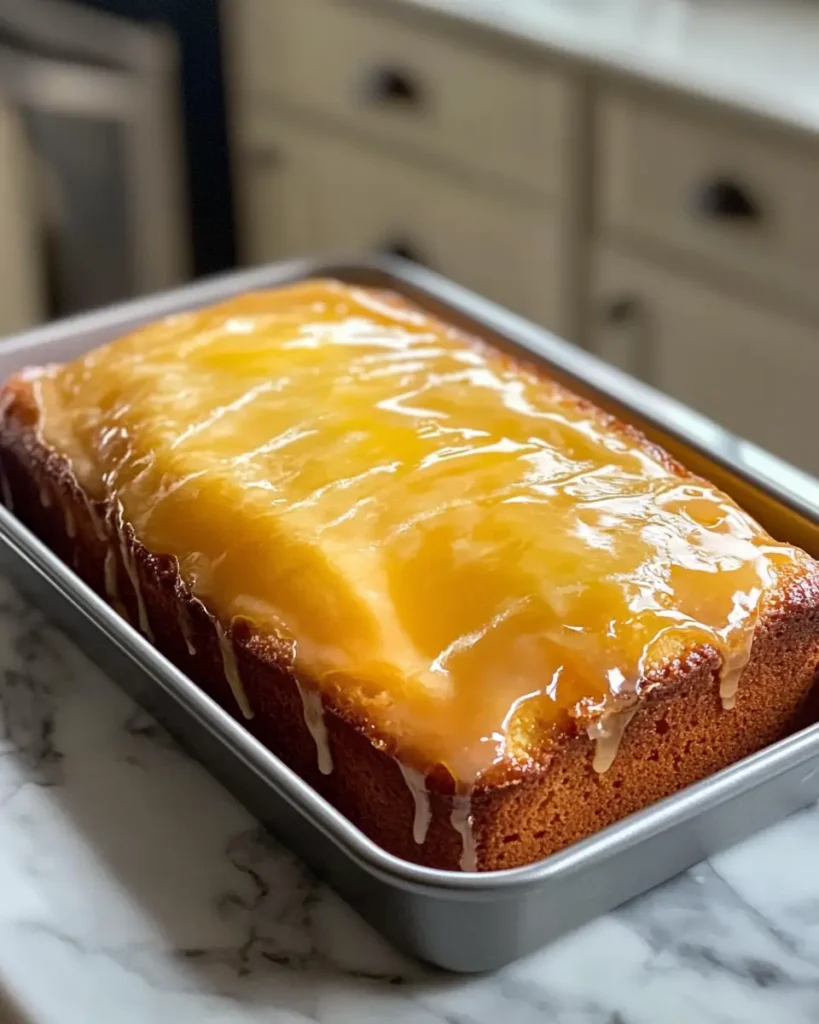1. Introduction
Table of Contents
As the late May air in Marrakesh carries the subtle scents of blooming flowers, there’s a certain comfort in a simple yet flavorful homemade cake. Today, we’re bringing you a recipe that embodies that warmth and zest: a Moist Lemon Cake with Lemon Glaze, inspired by the heartwarming simplicity of countryside baking. This cake is wonderfully tender, infused with bright lemon flavor, and topped with a tangy, sweet glaze that elevates it to a delightful treat.
This recipe focuses on creating a cake with a beautifully moist crumb and a vibrant citrusy punch. The combination of lemon zest in the batter and fresh lemon juice in the glaze ensures that every bite is a burst of sunshine. It’s an easy-to-follow recipe perfect for bakers of all skill levels, promising a cake that’s ideal for afternoon tea, a light dessert, or simply a moment of sweet indulgence. If you enjoyed the bright flavors of our Lemon Angel Food Cake, you’ll find this moist lemon cake to be a richer, equally delightful alternative. Let’s bring a touch of countryside charm to your kitchen!
2. Recipe Summary
- Cuisine: American, Dessert
- Difficulty level: Easy
- Total preparation and cooking time: 70 minutes
- Dietary classification: Not dairy-free.
3. Equipment and Utensils
- Large mixing bowl
- Electric mixer (handheld or stand mixer)
- Measuring cups and spoons
- Zester
- Juicer
- 9×5 inch (23×13 cm) loaf pan
- Wire rack
4. Serving Suggestions
- Plating: Serve slices of the lemon cake drizzled with the lemon glaze. You can garnish with a few thin slices of fresh lemon or a sprinkle of lemon zest for visual appeal.
- Side Dish Ideas: A dollop of whipped cream, a scoop of vanilla ice cream, or fresh berries would complement the cake nicely.
- Complementary Side Dishes: Consider serving alongside a light fruit salad.
- Wine or Beverage Pairings: A light, sweet white wine like Moscato or a crisp, dry Riesling. For non-alcoholic options, try a refreshing lemonade or a lemon-infused iced tea.
5. Nutritional Information
- Detailed Nutritional Breakdown (per serving, estimated):
- Calories: 300 kcal
- Carbohydrates: Approximately 40-45g
- Protein: Approximately 4-5g
- Fat: Approximately 12-15g
- Macronutrient Distribution: Roughly 55% Carbohydrates, 5% Protein, 40% Fat.
- Dietary Information: Not dairy-free.
- Potential Health Benefits: Contains some vitamins from the lemon.
6. Storage and Reheating
- Proper Storage Instructions: Store the lemon cake in an airtight container at room temperature for up to 3-4 days. Once glazed, it’s best stored at room temperature to maintain the glaze’s texture.
- Refrigeration Instructions: You can refrigerate the cake in an airtight container, which may help it last a bit longer, but it might slightly alter the texture, making it a bit denser.
- Freezing Recommendations: This lemon cake freezes well. Allow it to cool completely, then wrap it tightly in plastic wrap followed by aluminum foil, or place it in a freezer-safe bag. Freeze for up to 2-3 months. Thaw overnight at room temperature or in the refrigerator. Glaze after thawing.
- Reheating Methods: This cake is best enjoyed at room temperature and does not typically require reheating.
7. Expert Tips and Variations
- Tips from Professional Chefs: Ensure your butter is properly softened for a smooth and creamy batter. Zesting the lemons directly into the sugar can help release their oils and intensify the lemon flavor.
- Common Mistakes to Avoid: Overmixing the batter once the flour is added, which can lead to a tough cake; not allowing the cake to cool completely before glazing, which can cause the glaze to melt.
- Creative Recipe Variations:
- Other Citrus: Substitute lemon with lime or orange zest and juice for different flavor profiles.
- Poppy Seeds: Add 1-2 tablespoons of poppy seeds to the batter for a lemon poppy seed cake.
- Different Glazes: Experiment with a cream cheese glaze or a simple powdered sugar and water glaze.
- Seasonal Adaptations: This bright and zesty cake is perfect for spring and summer. You could serve it with seasonal fruits.
8. Ingredients Section
- For the Cake:
- 250g unsalted butter, softened (approximately 1 cup + 2 tablespoons)
- Quality and Sourcing Recommendations: Good quality butter makes a difference. Ensure it’s properly softened but not melted.
- 250g granulated sugar (approximately 1 1/4 cups)
- 4 large eggs
- Quality and Sourcing Recommendations: Use fresh eggs, preferably at room temperature.
- Zest of 2 lemons
- Preparation Notes: Use a zester to get fine zest, avoiding the white pith.
- 1 teaspoon vanilla extract
- 300g all-purpose flour (approximately 2 1/2 cups)
- Preparation Notes: Sifting the flour can result in a lighter cake.
- 1 teaspoon baking powder
- 1/2 teaspoon salt
- 1/2 cup milk
- Quality and Sourcing Recommendations: Any type of milk will work.
- 250g unsalted butter, softened (approximately 1 cup + 2 tablespoons)
- For the Glaze:
- 1 cup powdered sugar
- 2 tablespoons lemon juice
- Preparation Notes: Freshly squeezed is best for a bright flavor.
Metric Conversions (Approximate):
- 250g butter ≈ 1 cup + 2 tablespoons
- 250g sugar ≈ 1 1/4 cups
- 4 large eggs ≈ 200g (without shell)
- Zest of 2 lemons ≈ 2-3 tablespoons
- 1 teaspoon vanilla extract ≈ 5 ml
- 300g flour ≈ 2 1/2 cups
- 1 teaspoon baking powder ≈ 5 ml
- 1/2 teaspoon salt ≈ 2.5 ml
- 1/2 cup milk ≈ 120 ml
- 1 cup powdered sugar ≈ 120g
- 2 tablespoons lemon juice ≈ 30 ml
9. Step-by-Step Instructions
- Preheat Oven & Prep Pan: Preheat your oven to 175°C (350°F). Grease and flour a 9×5 inch (23x13cm) loaf pan.
- Preparation Note: This prevents the cake from sticking.
- Cream Butter and Sugar: In a large bowl, cream together the softened butter and granulated sugar until light and fluffy. Use an electric mixer for the best texture.
- Culinary Technique: Creaming incorporates air, which helps the cake rise and become tender.
- Add Eggs: Add the eggs one at a time, mixing well after each addition. This ensures they are fully incorporated into the batter.
- Incorporate Lemon Zest and Vanilla: Stir in the zest of 2 lemons and vanilla extract. The lemon zest adds a concentrated citrus flavor.
- Combine Dry Ingredients: In a separate bowl, whisk together the all-purpose flour, baking powder, and salt. This ensures even distribution of the leavening agent and salt.
- Alternate Wet and Dry Ingredients: Gradually add the dry ingredients to the wet ingredients, alternating with the milk, beginning and ending with the dry ingredients. Mix until just combined. Be careful not to overmix.
- Technique: Alternating helps maintain the batter’s emulsion and prevents overdevelopment of gluten.
- Pour into Pan: Pour the batter into the prepared loaf pan and spread evenly.
- Bake: Bake in the preheated oven for 50 minutes, or until a toothpick inserted into the center comes out clean. This indicates that the cake is fully cooked.
- Cool in Pan: Let the cake cool in the pan for 10 minutes before inverting it onto a wire rack to cool completely. This prevents the cake from breaking while it’s still warm and fragile.
- Prepare Glaze: While the cake cools, prepare the glaze by mixing the powdered sugar and lemon juice in a small bowl until smooth.
- Glaze the Cake: Once the cake is completely cool, pour the lemon glaze evenly over the top.
- Let Glaze Set: Allow the glaze to set and slightly harden before slicing and serving.
Sweet tooth calling? Share this easy & delicious Lemon Angel Food Cake recipe with your friends on Facebook or save it to your Pinterest boards for a sunny day treat!

10. Frequently Asked Questions (FAQ)
When to put lemon glaze on cake?
You should generally put lemon glaze on a cake once it has completely cooled. If the cake is still warm, the glaze will melt and become thin and runny, rather than setting nicely on top.
Do you glaze a cake when it’s warm or cold?
You should glaze a cake when it is cold. This allows the glaze to thicken and adhere properly to the surface, creating a smooth and appealing finish.
How to make lemon glaze Martha Stewart?
To make a lemon glaze similar to Martha Stewart’s, you’ll typically need: * Powdered sugar (also called confectioners’ sugar) * Fresh lemon juice * Sometimes, a little lemon zest for extra flavor.
When to put glaze on lemon loaf?
Similar to a regular cake, you should apply the glaze to a lemon loaf once it has fully cooled. This ensures the glaze doesn’t melt and creates a lovely coating on the loaf.

